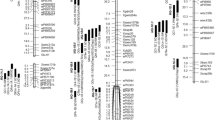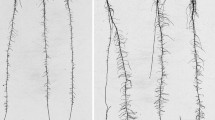Abstract
The first objective of this study was to map and characterize quantitative trait loci (QTL) for grain yield (GY) and for secondary traits under varying nitrogen (N) supply. To achieve this objective, a segregating F2:3 population previously developed for QTL mapping under water-limited conditions was used. The population was evaluated in Mexico under low N conditions in the dry winter season and under low and high N conditions in the wet summer season. From eight QTLs identified for GY under low N conditions, two were also detected under high N conditions. Five QTLs were stable across the two low N environments and five co-localized with QTLs identified for the anthesis-silking interval (ASI) or for the number of ears per plant (ENO) under low N conditions. The percentage of the phenotypic variance expressed by all QTLs for ASI and ENO was quite different when evaluated under low N conditions during the dry winter (40% for ASI and 22% for ENO) and the wet summer seasons (22% for ASI and 46% for ENO). The results suggest optimizing different breeding strategies based on selection index depending on the growing season. Good QTL colocalization was observed for ASI (four QTLs) and ENO (three QTLs) when looking at QTL identified under low N and water-limited conditions in the same population. The results suggest that that both secondary traits can be used in breeding programs for simultaneous improvement of maize against low N and drought stresses.



Similar content being viewed by others
Abbreviations
- ASI:
-
Anthesis-silking interval
- CHLO:
-
Chlorophyll content in ear leaf
- Ch:
-
Chromosome
- cM:
-
CentiMorgan
- ENO:
-
Number of ears per plant
- FFLW:
-
Female flowering
- GY:
-
Grain yield
- HKFW:
-
Hundred kernel fresh weight
- HN:
-
High nitrogen
- KNO:
-
Number of kernels per plant
- LNw/LNd:
-
Low nitrogen in the wet and dry season
- LOD:
-
Likelihood of odds
- MFLW:
-
Male flowering
- PHT:
-
Plant height
- QTL:
-
Quantitative trait locus
- QEI:
-
QTL by environment interaction
References
Agrama HAS, Moussa ME (1996) Mapping QTLs in breeding for drought tolerance in maize (Zea mays L.). Euphytica 91:89–97
Agrama HAS, Zakaria AG, Said FB, Tuinstra M (1999) Identification of quantitative traits loci for nitrogen use efficiency in maize. Mol Breed 5:187–195
Bänziger M, Betran FJ, Lafitte HR (1997) Efficiency of high-nitrogen selection environments for improving maize for low-nitrogen target environments. Crop Sci 37:556–561
Bänziger M, Lafitte HR (1997) Efficiency of secondary traits for improving maize for low-nitrogen target environments. Crop Sci 37:1110–1117
Bänziger M, Edmeades GO, Lafitte HR (1999) Selection for drought tolerance increases maize yields across a range of nitrogen levels. Crop Sci 39:1035–1040
Bänziger M, Edmeades GO, Lafitte HR (2002) Physiological mechanisms contributing to the increased N stress tolerance of tropical maize selected for drought tolerance. Field Crop Res 75:223–233
Basten CJ, Weir BS, Zeng ZB (2002) QTL cartographer, a reference manual and tutorial for QTL mapping. Department of Statistics North Carolina State University, Raleigh, 177 pp.
Bell MA, van Keulen H (1995) Soil pedotransfer functions for four Mexican soils. Soil Sci Soc Am J 59:865–871
Burgueño J, Cadena A, Crossa J, Banziger M, Gilmour AR, Cullis BR (2000) User’s guide for spatial analysis of field variety trials using ASRML. CIMMYT, México
Dwyer LM, Tollenaar M, Houwing L (1991) A non-destructive method to monitor leaf greenness in corn. Can J Plant Sci 71:505–509
Fracheboud Y, Ribaut J-M, Vargas M, Messmer R, Stamp P (2002) Identification of quantitative trait loci for cold-tolerance of photosynthesis in maize (Zea mays L.). J Exp Bot 53:1967–1977
Gallais A, Hirel B (2004) An approach to the genetics of nitrogen use efficiency in maize. J Exp Bot 55:295–306
Gleeson AC (1997) Spatial analysis. In: Kempton RA, Fox PN (eds) Statistical methods for plant variety evaluation. Chapman & Hall, London, pp 68–85
Grunau JA, Swiader J-M (1989) Ion chromatography in nutrient depletion studies: measurements of very low nitrate concentrations. Commun Soil SciPlant Anal 20:383–402
Hirel B, Bertin P, Quilleré I, Bourdoncle W, Attagnant C, Dellay C, Gouy Y, Cadiou S, Retailliau C, Falque M, Gallais A (2001) Towards a better understanding of the genetic and physiological basis for nitrogen use efficiency in maize. Plant Physiol 125:1258–1270
Jacobs BC, Pearson CJ (1991) Potential yield of maize determined by rates of growth and development of ears. Field Crop Res 27:281–298
Jiang C, Zeng Z (1995) Multiple trait analysis of genetic mapping for quantitative trait loci. Genetics 140:1111–1127
Lafitte R, Blum A, Atlin G (2003) Using secondary traits to help identify drought-toleerant genotypes. In: Fischer KS, Lafitte R, Fukai S, Atlin G, Hardy B (eds) Breeding rice for drought-prone environments. IRRI, Los Baños, Philippines, pp 37–48
Lafitte HR, Edmeades GO (1994a) Improvement for tolerance to low soil nitrogen in tropical maize. I. Selection criteria. Field Crop Res 39:1–14
Lafitte HR, Eadmeades GO (1994b) Improvement for tolerance to low soil nitrogen in tropical maize. III. Variation in yield across environments. Field Crop Res 39:27–38
Lemcoff JH, Loomis RS (1986) Nitrogen influence on yield determination in maize. Crop Sci 26:1017–1022
Lemcoff JH, Loomis RS (1994) Nitrogen and density influences on silk emergence, endosperm development, and grain yield in maize (Zea mays L.). Field Crop Res 38:63–72
Limami AM, de Vienne D (2001) Natural genetic variability in nitrogen metabolism. In: Lea PJ, Morot-Gaudry JF (eds) Plant nitrogen. Springer-INRA Editions, 407 pp
McCown RL, Keating BA, Probert ME, Jones RK (1992) Strategies for sustainable crop production in semi-arid Africa. Outlook Agric 21:21–31
Moll RH, Jackson WA, Mikkelsen RL (1994) Recurrent selection for maize grain yield: dry matter and nitrogen accumulation and partitioning changes. Crop Sci 34:874–881
Monneveux P, Ribaut J-M (2006) Secondary traits for drought tolerance improvmement in cereals. In: Ribaut JM (ed) Drought tolerance in cereals. The Haworth Press Inc., Binghamtown, NY, USA, pp 97−144
Monneveux P, Zaidi PH, Sanchez C (2005a) High density and low nitrogen affects yield and associated traits in tropical maize. Crop Sci 45:535–545
Monneveux P, Sanchez C, Beck D, Edmeades GO (2005b) Drought tolerance improvement in tropical maize source populations: evidence of progress. Crop Sci 45:180–191
Morris M, Dreher K, Ribaut J-M, Khairallah M (2003) Money matters (II): costs of maize inbred line conversion schemes at CIMMYT using conventional and marker-assisted selection. Mol Breed 11:235–247
Mugo SN, Smith ME, Bänziger M, Setter TL, Edmeades GO, Elings A (1998) Performance of early maturing Katumani and Kito maize composites under drought at the seedling and flowering stages. Afr Crop Sci J 6:329–344
Oikeh SO, Horst WJ (2001) Agro-physiological responses of tropical maize cultivars to nitrogen fertilization in the moist savanna of West Africa. In: Horst WJ (ed) Plant nutrition—food security and sustainability of agro-ecosystems. Kluwer Academic Publishers, Dordrecht, the Netherlands, pp 804–805
Pearson CJ, Jacob BC (1987) Yield components and nitrogen partitioning of maize in response to nitrogen before and after anthesis. Aust J Agric Res 38:1001–1009
Pingali PL, Pandey S (2001) Meeting world maize needs: technological opportunities and priorities for the public sector. In Pingali PL (eds) 1999/2000 world maize facts and trends. CIMMYT, Mexico, pp 1–24
Prioul JL, Quarrie S, Causse M, de Vienne D (1997) Dissecting complex physiological functions into elementary components through the use of molecular quantitative genetics. J Exp Bot 48:1151–1163
R Development Core Team (2005) R: a language and environment for statistical computing. R Foundation for Statistical Computing, Vienna, Austria. URL http://www.R-project.org
Raison RJ, Connell MJ, Khanna PK (1987) Methodology for studying fluxes of soil mineral-N in situ. Soil Biol Biochem 19:521–530
Reiter RS, Coors JG, Sussman MR, Gabelman WH (1991) Genetic analysis of tolerance to low-phosphorus stress in maize using restriction fragment length polymorphism. Theor Appl Genet 82:561–568
Ribaut J-M, Hoisington DH, Deutsch JA, Jiang C, Gonzalez-de-Leon D (1996) Identification of quantitative trait loci under drought conditions in tropical maize. 1. Flowering parameters and the anthesis-silking interval. Theor Appl Genet 92:905–914
Ribaut J-M, Hoisington DH, Deutsch JA, Jiang C, Gonzalez-de-Leon D (1997) Identification of quantitative trait loci under drought conditions in tropical maize. 2. Yield components and marker-assisted selection strategies. Theor Appl Genet 94:887–896
Ribaut J-M, Ragot M (2007) Marker-assisted selection to improve drought adaptation in maize: the backcross approach, perspectives, limitations, and alternatives. J Exp Bot 58:351–360
Tuberosa R, Salvi S, Sanguineti MC, Landi P, Maccaferri M, Conti S (2002) Mapping QTLs regulating morpho-physiological traits and yield in drought-stressed maize: case studies, shortcomings and perspectives. Ann Bot 89:941–963
Uhart SA, Andrade FH (1995a) Nitrogen deficiency in maize. I. Effects on crop growth, development, dry matter partitioning, and kernel set. Crop Sci 35:1376–1383
Uhart SA, Andrade FH (1995b) Nitrogen deficiency in maize. II. Carbon-nitrogen interaction effects on kernel number and grain yield. Crop Sci 35:1384–1389
Van Eeuwijk FA, Crossa J, Vargas M, Ribaut J-M (2002) Analysing QTL by environment interaction by factorial regression, with an application to the CIMMYT drought and low nitrogen stress programme in maize. In: Kang MS (ed) Quantitative genetics, genomics, and plant breeding. CABI Publishing, Wallingford, UK, pp 245–256
Westgate ME, Boyer JS (1986) Reproduction at low silk and pollen water potentials in maize. Crop Sci 26:951–956
Xu J, Pemberton GH, Almira EC, McCarty DR, Koch KE (1995) The Ivr 1 gene for invertase in maize. Plant Physiol 108:1293–1294
Zinselmeier C, Westgate ME, Schussler JR, Jones RJ (1995) Low water potential disrupts carbohydrate metabolism in maize (Zea mays L.) ovaries. Plant Physiol 107:385–391
Acknowledgment
The authors would like to thank D. Poland for his helpful editorial review of the manuscript.
Author information
Authors and Affiliations
Corresponding author
Rights and permissions
About this article
Cite this article
Ribaut, JM., Fracheboud, Y., Monneveux, P. et al. Quantitative trait loci for yield and correlated traits under high and low soil nitrogen conditions in tropical maize. Mol Breeding 20, 15–29 (2007). https://doi.org/10.1007/s11032-006-9041-2
Received:
Accepted:
Published:
Issue Date:
DOI: https://doi.org/10.1007/s11032-006-9041-2




